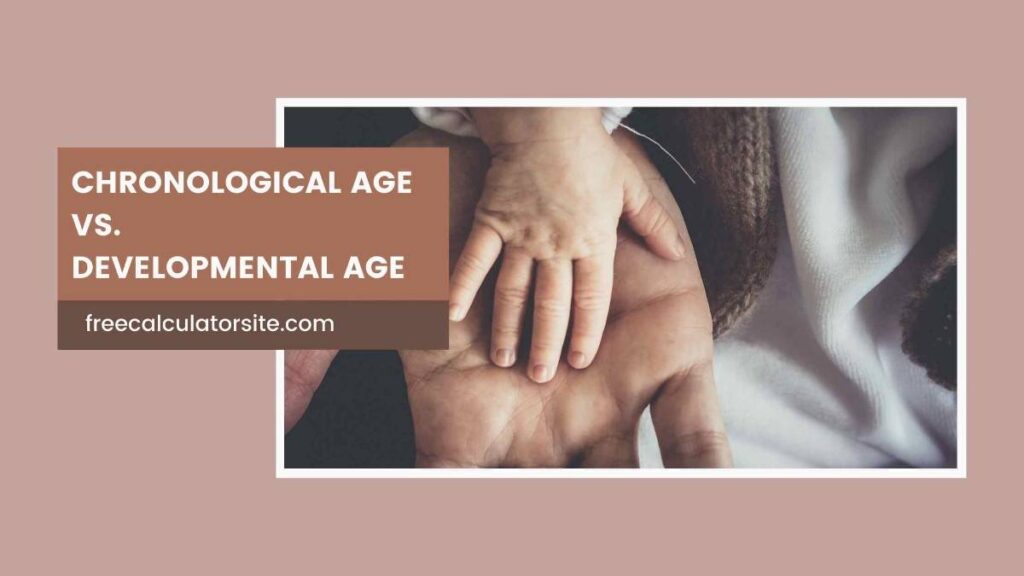Last updated on September 20th, 2024 at 09:04 pm

When it comes to understanding human growth, development, and aging, two key terms often come into play—chronological age and developmental age.
These concepts are crucial not only in the medical and educational fields but also in everyday life.
However, the distinction between them can sometimes be confusing. Let’s delve into what chronological and developmental age mean, how they differ, and why they matter.
What is Chronological Age?
Chronological age is the straightforward concept that most of us are familiar with.
It refers to the actual time that has passed since a person’s birth, measured in years, months, and days.
For example, if someone was born on September 14, 2000, their chronological age on September 14, 2024, would be 24 years.
Chronological age is often used as a basic metric in various areas of life, from defining legal rights and responsibilities to determining age-related milestones.
We use it when asking how old someone is, applying for a driver’s license, or calculating retirement age.
Chronological age is a clear and simple way to measure time, but it doesn’t always accurately reflect a person’s true stage of development or abilities.
What is Developmental Age?
While chronological age is measured in calendar years, developmental age focuses on a person’s physical, emotional, cognitive, and social maturity.
It looks beyond just how many years someone has lived and instead assesses how they have developed in relation to expected milestones for their age group.
Developmental age is often used in the fields of pediatrics, education, and psychology to assess whether a child or individual is progressing at a typical rate.
For instance, a 5-year-old child may have a developmental age that is either ahead or behind their chronological age.
If they show advanced language skills, social behavior, and motor abilities, their developmental age might be more comparable to that of a 7-year-old.
On the other hand, a child who struggles with speech or motor skills may have a developmental age closer to that of a 3-year-old, even though their chronological age is 5.
Also Read: Applications of Chronological Age
Key Differences Between Chronological and Developmental Age
Measurement:
- Chronological Age: Measured in years, months, and days from birth.
- Developmental Age: Based on milestones in cognitive, emotional, social, and physical development.
Scope:
- Chronological Age: A uniform and objective measure that applies equally to everyone.
- Developmental Age: Varies from person to person, as each individual develops at their own pace.
Indicators of Progress:
- Chronological Age: Indicators such as birthdays or legal milestones (voting age, retirement, etc.).
- Developmental Age: Assessed through various tools, tests, and observations in areas like language development, motor skills, emotional regulation, and social interaction.
Application:
- Chronological Age: Commonly used in legal, social, and cultural contexts.
- Developmental Age: Primarily used in education, healthcare, and developmental psychology to guide interventions and support.
Why is the Distinction Important?
The difference between chronological and developmental age becomes especially significant when we consider individual differences in growth and development.
Relying solely on chronological age to assess someone’s abilities or needs can be misleading.
This is particularly important for children, but it can also apply to adults in some contexts.
Educational Settings:
In schools, children are often grouped by their chronological age, but not every child develops at the same rate.
A child who struggles academically or socially may not be at the same developmental level as their peers, even if they share the same chronological age.
Conversely, a child who is more advanced may become bored or frustrated if their educational needs aren’t met.
Recognizing developmental age allows for more tailored approaches, whether it’s offering additional support or more challenging material.
Healthcare:
In healthcare, particularly pediatric care, understanding developmental age is crucial in diagnosing and treating conditions such as developmental delays, learning disabilities, or physical challenges.
For example, developmental screening tools assess whether a child is reaching expected milestones in speech, motor skills, and social interaction.
Early intervention is often key in helping children with developmental delays reach their full potential.
Social and Emotional Development:
Social and emotional maturity is another area where developmental age plays a critical role.
A teenager may have a chronological age of 16 but could display emotional responses typical of a younger child, which might require specialized guidance and understanding from parents, teachers, and counselors.
Understanding developmental age helps in creating environments that foster emotional growth at an appropriate pace.
Legal and Societal Considerations:
While laws are based on chronological age—such as the age to vote, drive, or drink alcohol—they don’t take into account whether an individual is developmentally ready for these responsibilities.
Some individuals may reach the legal age for certain rights and privileges but may not be developmentally prepared to handle them responsibly.
Factors Influencing Developmental Age
Many factors can influence a person’s developmental age, including genetics, environment, social factors, and experiences.
These influences can affect how quickly or slowly an individual progresses in different areas of their life.
Genetics:
Some developmental traits are inherited, meaning that biological factors can play a role in how someone develops physically and mentally.
For example, some children may reach physical milestones, like walking or talking, earlier or later than others due to genetic predispositions.
Environment:
A child’s home, school, and social environment can significantly impact their development.
Positive, stimulating environments that offer support, love, and learning opportunities tend to promote healthy development, while neglect or stress can slow it down.
Individual Experiences:
Personal experiences can also affect how a person develops. Trauma, illness, or significant life events may influence both cognitive and emotional growth.
On the other hand, enriched experiences, such as travel, learning opportunities, or diverse social interactions, can accelerate certain aspects of development.
Can Developmental Age Catch Up to Chronological Age?
One of the most common questions is whether a person’s developmental age can “catch up” to their chronological age, especially in cases of developmental delay.
In many cases, with appropriate interventions, support, and time, children can progress to a developmental age that aligns more closely with their chronological age.
However, it’s also important to recognize that developmental progress isn’t always linear—some areas of development may advance while others take more time.
Conclusion
Understanding the distinction between chronological age and developmental age is essential for creating supportive, effective environments, whether in education, healthcare, or everyday life.
While chronological age provides a simple and uniform measure of time, developmental age offers a more nuanced view of a person’s abilities and growth.
Recognizing these differences allows us to better meet the needs of individuals at all stages of life, ensuring that each person has the opportunity to thrive according to their unique developmental journey.

Sayantika Karmakar provides expert insights on financial calculators in her blog posts.
